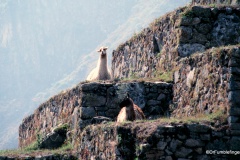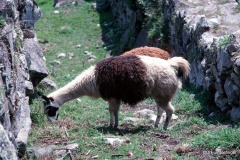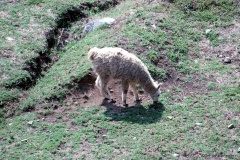Get update alerts
Locations
- .All Trips
- Art
- Car Culture
- Central America/Caribbean
- Food
- Food Tour
- Pic of the Week
- Sl;ovenia
“Pic of the Week”, July 16, 2021: Grass Cutters of Machu Picchu

It’s tough for people to cut grass that’s terraced or growing on steep hills, but it’s enjoyable for llamas and alpacas.
When we visited Machu Picchu, we noticed a number of these woolly creatures grazing on the grass, or resting and chewing their cud. The grass was well trimmed throughout the site. A practical solution to a problem.
(Click on thumbnails to enlarge and right arrow to advance slideshow)
Jul 15, 2021
Comments Off on “Pic of the Week”, July 16, 2021: Grass Cutters of Machu Picchu
.All Trips / Peru / South America

Trekking on the Original Inca Trail

I’ve enjoyed hiking and walking all of my life. One of my most memorable treks was the Inca Trail in Peru. Hard to believe it’s been 25 years since my brother and I did that walk, and I’m glad I did it then because my worn knees would not be up to the task today.
The hike lasted four days and wound its way up and down and across the Andes, starting in a desert climate and ending in a cloud forest. Our highest altitude was 4200 m (13,800 ft), a level at which it’s quite cool even when so close to the equator.
The trail has a lot of ups and downs, and it’s hard work as the pitch is so …
Tagged hiking, Inca Trail, Machu Picchu, trekking
.All Trips / Central America/Caribbean / Peru / South America

The floating islands of Lake Titicaca, Peru

I don’t anywhere people live on floating islands except for the Uros Islands of Lake Titicaca, a large lake straddling Peru and Bolivia (the Peruvians like to say they got the “titi” part, while the Bolivians got the “caca”). It’s the most voluminous lake in South America and is considered the highest navigable — by a large ship — lake in the world, having a surface elevation of 3,812 m or 12,507 ft.
The Uros natives of the lake are a pre-Incan people who live on forty-two floating islands. They had a unique language (which has been lost for centuries) and obviously a unique way of living. They historically moved to the floating islands for defensive purposes. Some of the islands …
Tagged Bolivia, floating island, Lake Titicaca, Peru, reeds, Uros
“Pic of the Week”, October 9, 2015: Piranha, Rio Oroso, Peru

One of my most memorable trips was a week spent aboard a floating houseboat on one of the tributaries of the Amazon River. It was the Rio Oroso in Peru, about a 6 hour boat ride from Iquitos. While the Amazon itself is massive, several miles wide even more than a thousand miles from it’s mouth, you need to head into its tributaries to find the Amazon jungle.
The houseboat was primitive, a building made of logs and thatched roof, floating in a river, kept in place by ties to the bank. No electricity, although river water was pumped into a tank in the ceiling so we were able to shower and such (although you couldn’t drink it). The sun set …
Oct 8, 2015
Comments Off on “Pic of the Week”, October 9, 2015: Piranha, Rio Oroso, Peru
.All Trips / Peru / South America

The Nazca Lines, Peru

If you drive south of Lima on the Pan Am Highway in Peru, you’ll drive by (and through) the Nazca Desert along the foothills of the Andes. This is one of the driest places in the world. The average rainfall is less than an inch (<2 cm) a year and some years there’s no rain at all. The Nazca Lines are an amazing group of geoglyphs etched into the surface of the desert. There are about 300 hundred figures that comprise the Nazca lines including, besides lines, geometric shapes and pictures of animals and birds.
Along the highway you can stop at the Mirador tower, built along the Pan Am highway. This tower allows people to climb up and see a …
Tagged desert, geoglyphs, Nazca lines, UNESCO World Heritage Site
“Pic of the Week”. July 12, 2013. Scarlet Macaw, Peruvian Amazon

One of the thrills of traveling to the Amazon rain-forest is to see its large colorful flocks of birds. The most spectacular of these are scarlet macaws which are actually not just scarlet but a combination of red, yellow and blue. To watch them in flight is to see color become fluid and take life.
My brother and I visited the Peruvian Amazon after hiking the Inca Trail. We spent a few nights at the Tambopata Lodge situated in a National Reserve, a long boat trip upriver from the airport at Puerto Maldonado. The lodge is in the heart of a beautiful rain-forest and offers the advantage of cool evening breezes from the barely visible Andes to the west which provide …
Jul 11, 2013
Comments Off on “Pic of the Week”. July 12, 2013. Scarlet Macaw, Peruvian Amazon
“Pic of the Week”. January 11, 2013. Alpaca herd, near Sullustani National Monument, Peru

This photo was taken on the high altitude plateau (Altiplano) of Peru located over 13,000 ft (4,000 m) above sea level, not far from Lake Titicaca. Given the high altitude, agriculture is limited, mostly potatoes and livestock (sheep, llamas, alpacas). My brother and I were en-route from Puno to the Sullustani National Monument when we encountered this herd of alpacas. We decided to stop for a photo and cautiously approached the herd.
These alpacas were very curious but leery of us. The large white woolly alpaca in the left foreground of the photo was the alpha male and was of bad temperament. He charged at us twice wanting to spit on us (which usually involves regurgitated stomach contents, a type …



